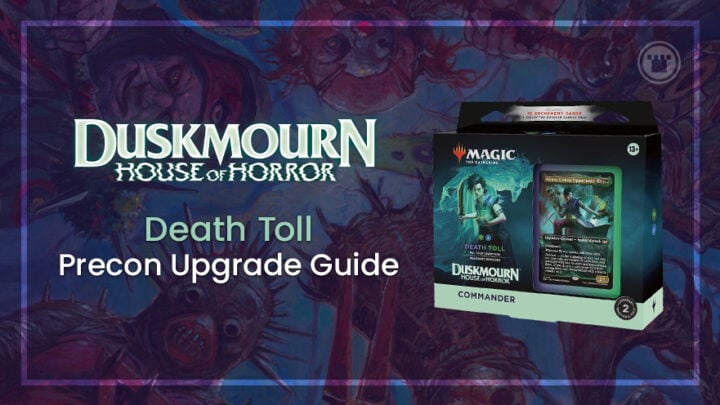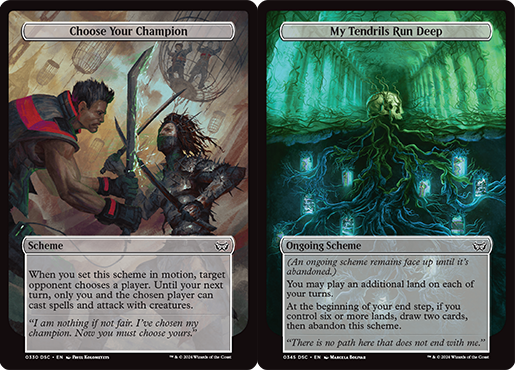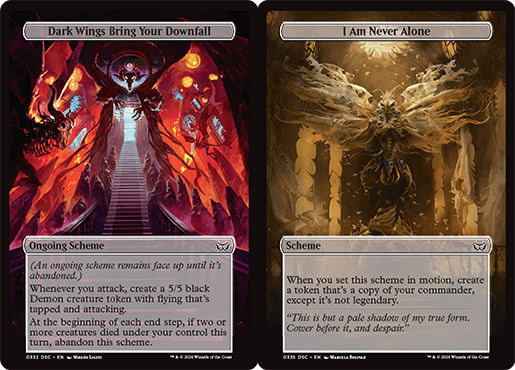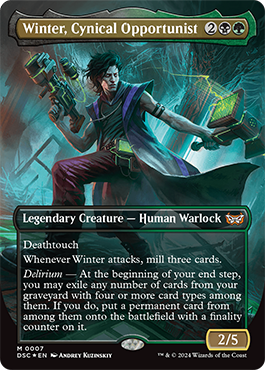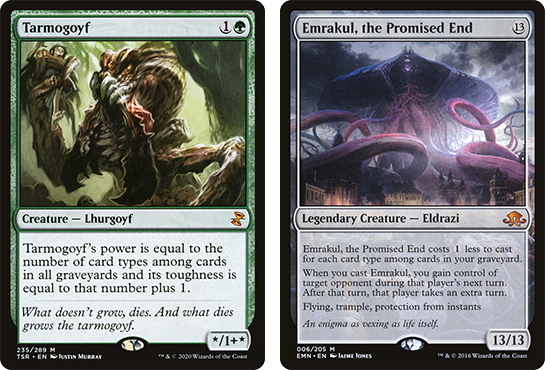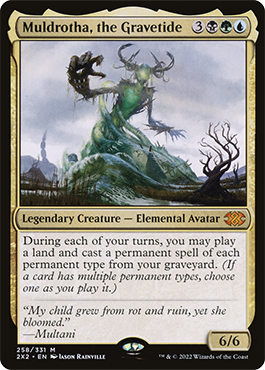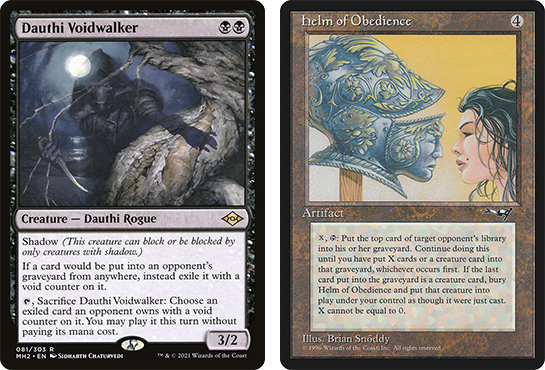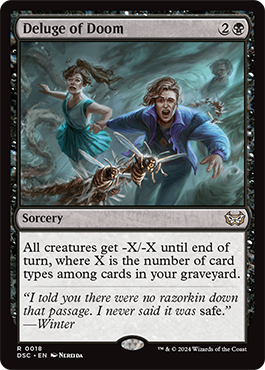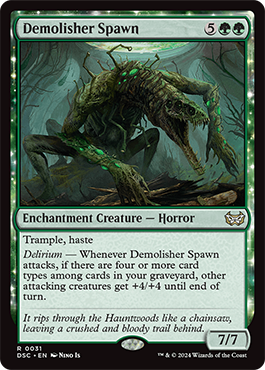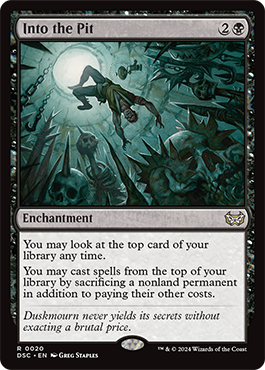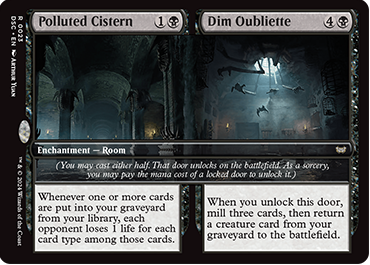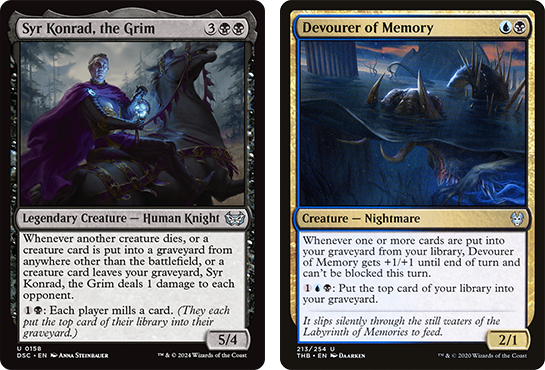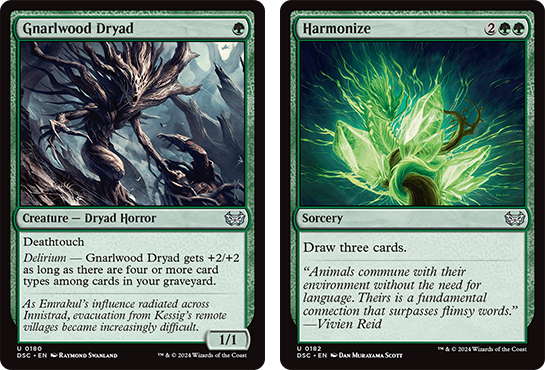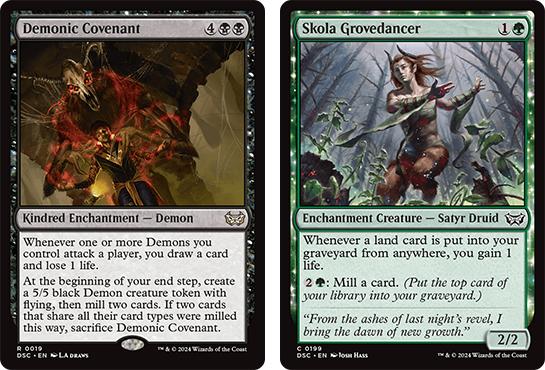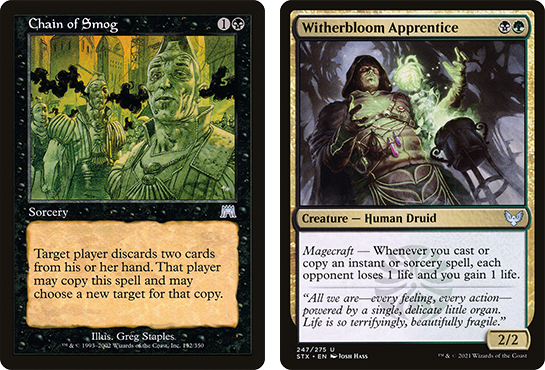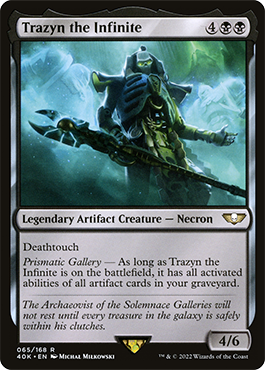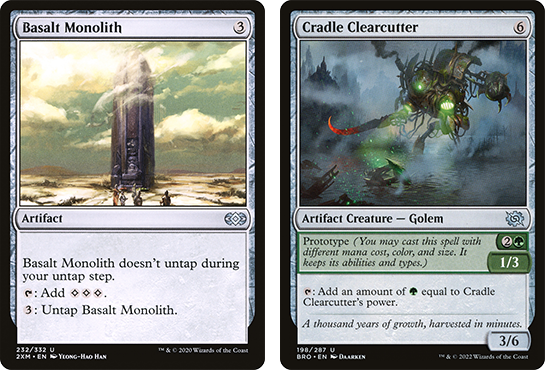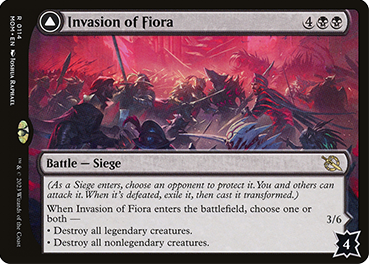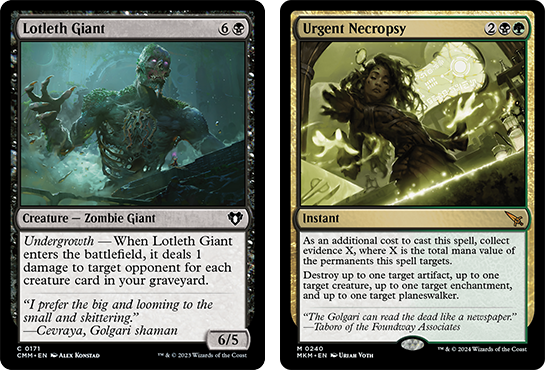We’re counting down to the release of Duskmourn, an expansion that seems to pack as many thrills and unexpected turns as the horror movies which inspired it. The set’s mechanics, its color pie, its arch-villain, even the modern-day aesthetic all feel new and uncertain, and the spoiler season has hit us with more than a few jump scares…
Now, the Death Toll Commander precon carries on this fearful theme – by bringing the Archenemy format back from the dead!
TAKE DOWN THE BIG BAD – OR *BE* THEM!
To be clear for anyone who isn’t familiar: Archenemy isn’t a format with special deckbuilding rules. So Death Toll and the other precons for this set are playable in “normal” Commander games as well!
Unlike older Archenemy products, all four are designed to work well in the villain role – even if it seems weird to imagine the Valgavoth-led Endless Punishment deck playing nice with “fellow heroes”. That means that all of them come with a deck of powerful Scheme cards which, along with a few special rules, help the villain player keep even with multiple opponents.
I won’t really say much more about the Archenemy side of the Death Toll precon today – that might have to wait for a more general discussion of these precons as a set. But I will say that I’ve always had fun with Archenemy products. They’re especially cool for offering a kind of curated Magic-as-boardgame experience that Magic players and non-players can enjoy together.
Having Schemes and revised Archenemy rules included in the box is a sweet little bonus to keep in mind as we dig into the rest of what Death Toll offers!
MEET THE COMMANDER
As one might expect of a person who has survived the horrors of Duskmourn alone for countless years, Winter has a strong affinity for Delirium – a graveyard mechanic you might remember from Shadows over Innistrad, Modern Horizons sets, or your favorite outdated Constructed staples.
Other graveyard commanders usually push us to either fill our graveyard with as many cards as possible, or to get specific cards there to set up a particular combo. But delirium is somewhere in the middle. It requires both quite specific deckbuilding AND a good bit of luck or effort if you want to turn it on early in a game.
This slow start and the fact it doesn’t naturally scale after that point (you either have delirium, or you don’t) means that it usually won’t provide you directly with a win condition. That’s why the best comparison points for Death Toll’s playstyle are value-driven graveyard decks like Muldrotha, Sivriss, Kagha, or Kess.
Muldrotha in particular is going to be an obvious example to follow when building around this commander. I can even see a segment of players who might want to re-tool their Muldrotha decks into Winter decks: whether to down-grade from such a common and feared commander choice, or just to gain a more focused play style and color identity.
For all the similarities that can be drawn to other legends, Winter does also have some unique charms. His ability to directly reanimate permanents does give him explosive potential beyond the other delirium commanders I mentioned, making it easier to assemble winning combos.
I also like the implications of having three of the four cards involved only matter for their type. This means we can potentially choose one or two card types to be our reanimation payoffs, and then prioritize other card types across the rest of the deck – particularly on any cheap cards we’re using to load the yard early. This lets us optimize for early and impactful use of Winter’s ability, while still having plenty of room for unique gameplans across different builds – something always appreciated for a precon Commander that will see a lot of play in the next few months.
NEW TECH REVIEW
New cards are always a big selling point for me when looking at precons, since I’m much more likely to break them down for parts than keep them intact as a permanent part of my lineup.
Deluge of Doom
Deluge of Doom may not be as innovative as some of the other new designs in Death Toll, but it makes up for that with sheer efficiency. The bar for “Eternal-playable -X/-X sweeper” is set somewhere between Toxic Deluge and Languish. Considering that even a not-especially-delirious deck can probably scale this up faster than it can play Swamps for Mutilate – AND that it’s a whole mana cheaper – Deluge is basically debuting as the 2nd-best version of this very desirable effect. There’s Constructed potential here.
Demolisher Spawn
Would you believe that just this week, I was sitting around lamenting that I couldn’t find a really good Craterhoof-type finisher for my Meren of Clan Nel Toth deck? I can scarcely imagine a better fit for that spot than Demolisher Spawn. It has haste to attack immediately once reanimated, and a reusable and chunky Overwhelm effect to turn your other random creatures into a lethal army. You don’t even need to be a “graveyard deck” to use it – getting delirium by the time you’re ready to win is really not a serious obstacle.
Formless Genesis
Any card with changeling or that creates changelings is immediately notable for all the niche typal decks out there, who are happy just to get a new Aurochs card (or Hyena, or Lhurgoyf…). You also get opportunities for weird ability overlaps where the changelings can utilize different typal buffs at the same time. But it’s especially noteworthy when the card is also a noncreature spell, as the possibilities for unprecedented and nasty interactions get much higher.
For instance, you can re-cast Formless Genesis over and over from your yard using Haakon, Stromgald Scourge. Or you can do that without Haakon, because this ALSO has Retrace on top of the other stuff. I can’t wait to see what madness people brew up with this one!
Into the Pit
My first read of this card was a terrifying rollercoaster ride, but in the end it seems to be a pretty-fun-but-not-ruinously-overpowered draw engine.
Yes, it has shades of gamebreakers like Bolas’s Citadel and Underworld Breach. But Into the Pit cannot negate mana costs like the former, nor allow for repeated casts of the same spells like the latter. So what DOES it do? Give Commander players even more reason to not run Phyrexian Arena ever again!
Polluted Cistern//Dim Oubliette
The other new cards are pretty strong, but I’m confident I saved the best for last! Polluted Cistern unlocks the dangerous opportunity to convert self-mill (not usually a hard effect to achieve) into immediate wins.
It’s a lot cheaper than Syr Konrad, and more consistent than Devourer of Memory – the only two other cards I’m aware of which can do this. Again, very high likelihood this is a reasonable way to win in Legacy, or even cEDH. Being an enchantment makes it harder to remove, and even if you rarely unlock Dim Oubliette, having it there is pure upside.
The only real hurdle in your way here is that you won’t win by milling your whole deck in one shot – you need to mill cards in ones or twos to guarantee lethal. But that just means you’re going to plug this into one of the already–established combo engines which does that. “Polluted Cistern” is the perfect name for this Room – ‘cause it’s gonna be the source of a lot of toxicity going forward!
$50 UPGRADE GUIDE
I like to start any upgrade by figuring out what will be the core identity and win conditions of our deck. That way we can evaluate which cards to cut based on the proper context, and understand roughly what kind of effects the deck still needs.
Winter’s abilities seem to encourage a classic GB midrange playstyle where we run a bunch of powerful, loosely synergistic permanents with different card types and a focus on self-mill. All we need to do to win is make sure some of our strong permanents happen to go infinite with each other. Then we can proactively try to assemble those combos whenever opponents look like their shields are down, probably by casting one half and then reanimating the other with Winter’s end-step trigger.
Cuts
We’re looking to make space by cutting outright bad cards, as well as any which feel like bad fits for our plan. If we’re trying to install whole new combo packages into the list we might need a lot of slots, so I intend to be pretty ruthless in terms of slashing anything that doesn’t seem directly aligned with our mill-and-kill style.
One rule I’m trying to follow here is trying to make a list that’s more obviously polarized into reanimation targets and delirium enablers. If we intend to actually cast a spell, then it should be cheap, and if not then it should be as expensive and gold-plated as possible! I’m also trying to cut more creatures than other card types to improve our balance for delirium.
Here’s the full list of cuts from the deck:
Ob Nixilis Reignited
Demonic Covenant
Deathreap Ritual
Inscription of Abundance
Convert to Slime
Harmonize
Whispersilk Cloak
Burnished Hart
Carrion Grub
Giant Adephage
Gnarlwood Dryad
Moldgraf Millipede
Obsessive Skinner
Old Stickfingers
Rendmaw, Creaking Nest
Sakura-Tribe Elder
Scavenging Ooze
Skola Grovedancer
Solemn Simulacrum
Suspicious Bookcase
Ursine Monstrosity
Vile Mutilator
Jungle Hollow
Additions
The actual upgrades come in here, and can be neatly divided into a few packages.
Our first combo wincon is piggybacking off a card that’s already in the list – Professor Onyx. We don’t have a ton of ways to utilize her magecraft, but it turns out you only need one Chain of Smog to generate infinite triggers (by targeting yourself and choosing to copy over and over). We can also add Witherbloom Apprentice for some combo redundancy, since it will also trigger lethal when we cast Chain. It’s a little sad that Chain is a sorcery and not a permanent, but Eternal Witness means we can still get it back with reanimation if we have to.
For our second combo package we have my favorite example of nominative determinism in Magic: Trazyn the Infinite. There’s a few reasons to like the legendary Necron here, but the biggest is he’s a “one-card combo”. So long as we have milled enough to get the right mix of artifacts in our yard, Trazyn can threaten any number of game-ending combos without needing to resolve or reanimate a second card.
Here, the requirements to combo off include milling Pili-Pala or Basalt Monolith (to give Trazyn a self-untap ability) plus any artifact which can tap to produce more than three mana at a time, producing a profitable mana loop! Infinite mana equals infinite untaps, equals infinite uses of Staff of Nin or another lethal artifact ability.
Moving on from these win conditions, I tried to give the delirium theme a boost by adding in Battles! These give us even more chances to hit that key four-card-types threshold, while performing reasonably as interaction or utility spells. The other path to improving our consistency with delirium is just adding more and cheaper graveyard-filling effects.
The Gitrog Monster deserves special mention: already game-winning on its own, combining it with Patchwork Gnomes and Dakmor Salvage allows you to dredge the Salvage over and over. You can use this to get pieces in place for a different combo – or just win, if you happen to have Syr Konrad or Polluted Cistern in play already!
Here’s the full list of additions to the deck:
Invasion of Ixalan
Invasion of Fiora
Invasion of Shandalar
Invasion of Innistrad
Crop Sigil
Sinister Concoction
Buried Alive
Chain of Smog
Traverse the Ulvenwald
Basalt Monolith
Nyx Lotus
Staff of Nin
The Celestus
Cradle Clearcutter
Eternal Witness
Patchwork Gnomes
Pili-Pala
Syr Konrad, the Grim
The Gitrog Monster
Trazyn the Infinite
Witherbloom Apprentice
Dakmor Salvage
Shifting Woodland
You can check out the full decklist for the entire list of changes made in this upgrade.
THE WINTER OF *THEIR* DISCONTENT
I hope this breakdown has helped you form a clearer idea of whether the Death Toll precon is right for you and your playstyle. This kind of grindy, variance-heavy self-mill plan isn’t going to be as explosive or consistent as some other popular Commander decks, but I know there is a set of players out there who love to play a methodical and reactive style, and Winter lays out a really cool way to do that.
I especially love that there’s so much choice and potential to customize the decklist here while still retaining a unique identity from Winter’s reanimation mechanic. If you had a bit more cash to invest, you could easily have fit in totally different win conditions and combos – ideally, ones which can be used to win at instant speed after Winter triggers in your end step instead of waiting a full turn cycle to go for it!
There’s even more flexibility when you start plugging in different graveyard-payoff mechanics like collect evidence or undergrowth. Cards which don’t need Winter’s help coming back from the dead thanks to escape, encore, flashback or the like are also great for keeping more options open during the game.
I encourage you to explore your own way through this complex maze of thought – after all, Winter makes it very clear that you can only trust a guide so far!

Tom’s fate was sealed in 7th grade when his friend lent him a pile of commons to play Magic. He quickly picked up Boros and Orzhov decks in Ravnica block and has remained a staunch white magician ever since. A fan of all Constructed formats, he enjoys studying the history of the tournament meta. He specializes in midrange decks, especially Death & Taxes and Martyr Proc. One day, he swears he will win an MCQ with Evershrike. Ask him how at @AWanderingBard, or watch him stream Magic at twitch.tv/TheWanderingBard.

